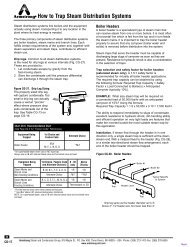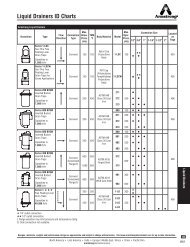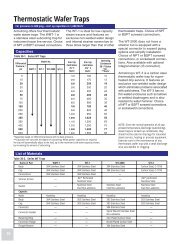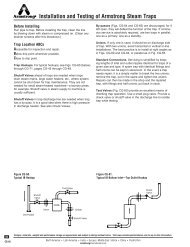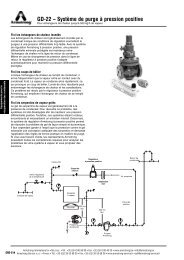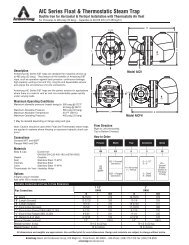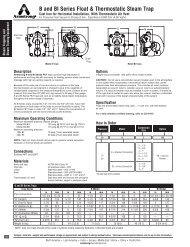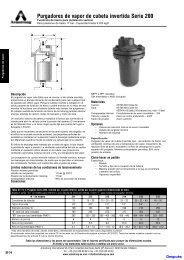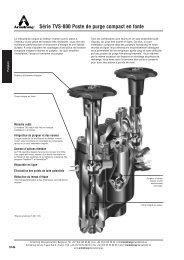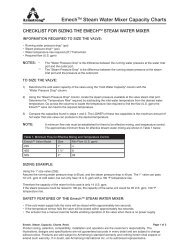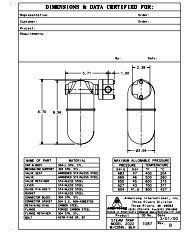550.pdf (2.39 MB) - Armstrong International, Inc.
550.pdf (2.39 MB) - Armstrong International, Inc.
550.pdf (2.39 MB) - Armstrong International, Inc.
Create successful ePaper yourself
Turn your PDF publications into a flip-book with our unique Google optimized e-Paper software.
Why Humidification?<br />
Humidification reduces heating costs.<br />
All forms of humidification provide a variety of<br />
benefits, not the least of which is a reduction in<br />
heating load for human comfort. Studies indicate<br />
people are generally most comfortable when relative<br />
humidity is maintained between 35% and 55%.<br />
When air is dry, moisture evaporates more readily<br />
from the skin, producing a feeling of chilliness even<br />
with temperatures of 75°F (23°C) or more.<br />
Because human perception of RH is often sensed<br />
as temperature differential, it’s possible to achieve<br />
comfortable conditions with proper humidity control<br />
at lower temperatures. The savings in heating costs<br />
are typically very significant over the course of just a<br />
single heating season.<br />
Efficient use of warm, dry outside air reduces<br />
cooling costs.<br />
Some outdoor climates require both cooling<br />
and humidification to achieve the desired<br />
indoor conditions. Obviously, economizers<br />
cannot deliver free cooling when the<br />
outside air is warmer than the desired<br />
zone temperature. However, if the humidity<br />
levels are low, such as in dry environments,<br />
significant free cooling may be achieved with<br />
an evaporative humidification system.<br />
This is true for both mixed air and 100%<br />
make-up air systems. If fact, many non-desert<br />
climates experience significant cooling and<br />
humidification hours each year.<br />
Efficient use of internal heat gain and waste heat<br />
can yield up to a 90% reduction of energy costs<br />
compared to steam humidification.<br />
Large commercial offices and manufacturing<br />
facilities can have an extended cooling season or<br />
year round cooling load. In such situations, a mixed<br />
air economizer system can be employed to exhaust<br />
warmer return air and replace it with cooler outside<br />
air. Although free cooling is achieved, the dryer<br />
outside air actually increases the humidification load<br />
and humidification energy consumption.<br />
Instead of exhausting the warmer return air,<br />
foggers use the warm return air to evaporate water.<br />
Humidification is achieved without the energy<br />
required to boil water and economizer cooling is still<br />
achieved without mechanical refrigeration.<br />
50-60% reduction of economizer humidification<br />
load and associated energy costs.<br />
Because of the cooling experienced with fogging<br />
systems, economizer systems can run at higher<br />
mixed air temperatures which means less outside<br />
air is required. Therefore, the humidification load is<br />
greatly reduced compared to the conventional steam<br />
humidification load.<br />
Ultra clean humidification source.<br />
Deionized water is used for an ultra-pure<br />
source of humidification to maintain a<br />
non-contaminated environment.<br />
Energy savings with clean rooms.<br />
PressureFog is clean room humidification<br />
that requires ultra-pure water as a<br />
humidification source. As ultra-pure<br />
water is considered corrosive at elevated<br />
temperatures, PressureFog is all stainless<br />
steel constructed, eliminating corrosion.<br />
In many applications, a stainless steel re-boiler<br />
would be used to accomplish clean room<br />
humidification with ultra-pure water. Due to the<br />
inefficiencies of the heat exchange process<br />
in re-boilers, PressureFog is more energy<br />
efficient.<br />
4<br />
Designs, materials, weights and performance ratings are approximate and subject to change without notice. Visit armstronginternational.com for up-to-date information.<br />
North America • Latin America • India • Europe / Middle East / Africa • China • Pacific Rim<br />
armstronginternational.com



